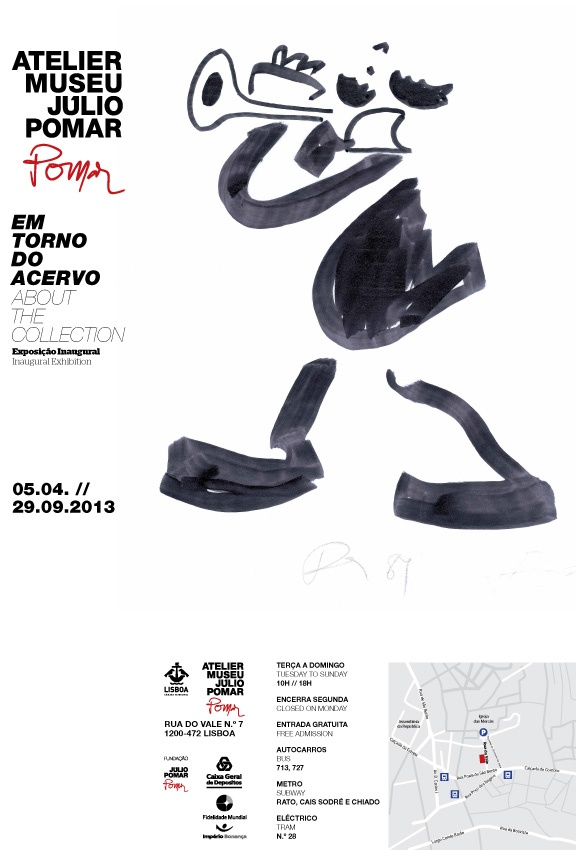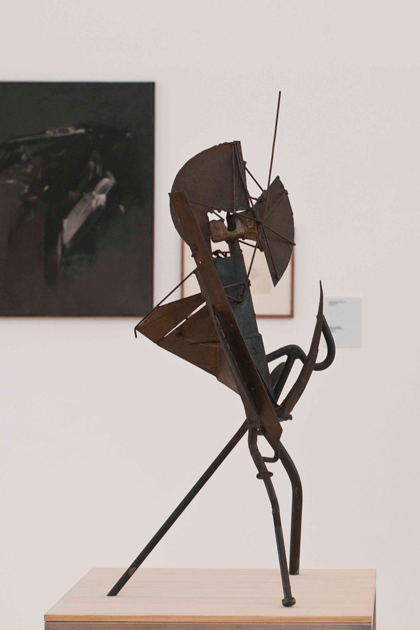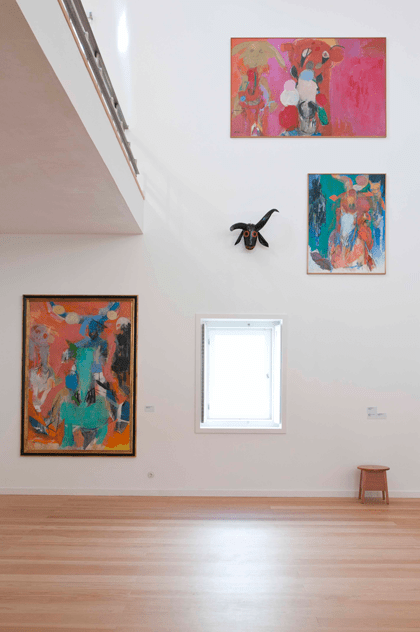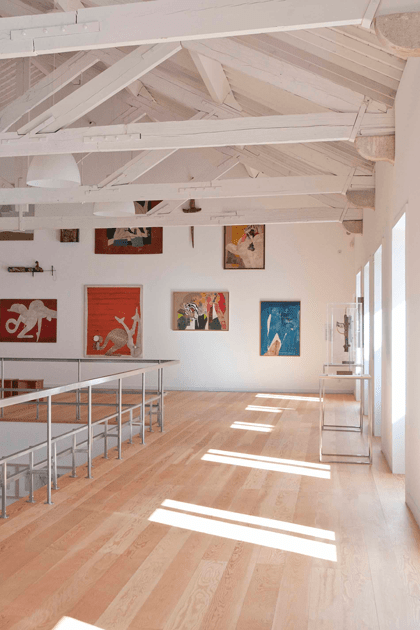
The opening exhibition at the Atelier-Museu reveals part of the collection which the Júlio Pomar Foundation deposited at the municipal museum, highlighting several of the most relevant periods in the artist’s work. As well as works belonging to the deposit, the inaugural exhibition includes other pieces loaned by prominent institutions and collections in which the artist is represented, which are considered fundamental in the artist’s career.
Viewing each painting as an integral part of his work as a whole, the exhibition criteria adopted for the first exhibition of the collection did not follow a chronological order in the positioning of the works in the space. The exhibition is organised into four main sections, which allow different stages of the artist’s career to be revisited, challenging the viewer to discover the relationships between works and between the different styles adopted, as well as to reflect on the questions raised within them.
One section is dedicated to the 1980s and 90s, when the artist made a return to painting after exploring other visual media, developing a pictorial language in which colour and the expressionist gesture are taken to their limits.
One example of this is the series featuring the indigenous people of the Alto Xingú region of the Amazon, following a stay in which the painter accompanied filming of ‘Kuarup’ by Ruy Guerra. His contact with this community was an experience which transformed the painter’s gaze, that is, the way in which he came to view reality from that moment on, which he transposed onto his paintings. Through these paintings, depicting the freedom with which the indigenous people moved, bathed and embraced without regard for social constraints, the artist tests different relationships between the bodies and the surrounding space. From this transient experience in the community, the artist learned, above all, that the act of seeing transcends the immediacy of the image, that images are composed of multiple thicknesses and layers, and that it is necessary to keep one’s gaze free from deeply rooted formats and preconceptions.
Other works from this period include several pieces from the ‘Mascarados de Pirenópolis’ series, a celebration with profane and religious elements observed by the painter at the Festival of the Divine Holy Spirit held in the city of Pirenópolis in Brazil. These celebrations feature ancestral rituals encompassing the mythical, festive and ritualistic dimensions of humanity. During the ritual, the typical masked figure dresses in clothing made from whatever can be found, often in intense colours, decorated with paper flowers. The figure wears a mask alluding to the ox, the leopard or the devil, hinting at sacrifice and death. Strange and spooky, the ‘Mascarados de Pirenópolis’ take on an almost shamanic nature at the Atelier-Museu Júlio Pomar, As if they were the de facto guardians of the space.
In a simultaneously unreal and anthropomorphic setting, the artist’s painting explores an area of unexpected associations, in which disparate elements – animals and human beings, objects and masks, forms and colours – combine in a hybrid manner on the surface of the painting, appearing and disappearing from it, emerging once again, intertwining and rejecting any kind of pre-stipulated logic. From then until now, the surface of the canvas, acting as a screen for memory, offers ambiguous signs which suggest other, invisible marks, harnessing a fertile field of associations and denying attempts at stylistic framing.
Another section of the exhibition focuses on the 1960s, which saw painting become autonomous as a mode of expression. Although themes relating to bullfighting and horse racing can be identified in these works, it cannot be said that they are the central focus. During this period, the artist opted for a gestural language whose main object of exploration is movement itself. The section includes drawings and several prints which demonstrate the way in which the principles of painting reappear and are explored through other visual media.
A glimpse back in time allows viewers to revisit paintings from the neorealist period of the 1940s and 50s, an expression intended to closely reflect the social context, in a politically engaged manner and, most of all, comprehensible to the viewer. Committed to close examination of reality, Júlio Pomar nonetheless refused to limit his artistic practice to a pamphletary interpretation. Characterised by dark tones and curved, sinuous lines, the pictorial language used allows figures to be glimpsed between figures, as depicted in ‘Resistência’, or takes on a formal rigidity which lends the forms the appearance of masks or geometric solids, as in ‘Azenhas do Mar’. Able to communicate metaphorically that which could not explicitly be said at the time, Júlio Pomar’s painting from this period did not go unnoticed in the political context of the time, and as such, cannot be forgotten in the origins of his work. It thus plays an important role in the Atelier-Museu, a place which symbolises the place of origin of art objects.
The final section features works which are representative of one of the most daring periods in Júlio Pomar’s career, which would permanently define his visual language: collage and assemblage. Often difficult to grasp due to the multitude of references contained within, it was in the world of collage that the artist more radically questioned his work. Originating in the 20th century with Braque and Picasso, in Pomar’s work collage takes on a free, daring dimension. As well as questioning the reality of the painting, which comes to include pieces of daily life (paper cut-outs, cartoons, fabrics and other objects), the medium of expression is assumed as a place for projecting the various dimensions of the body. Layer upon layer, like skin on skin, the artist demonstrates to the viewer that the artwork is a place for the body, and therefore, a place for feeling the relationships and erotic entanglements, as embodied in ‘La table de l’architecte’ (1977), for example. The idea of joining and combining present in these collages can also be seen in drawings such as ‘Étreinte’ (1979), whose title emphasises either the intertwining of the bodies, or their possibility of fitting together. In this context, the emergence of collages in which the human body merges with and blurs into the animal world of felines is no surprise. The body is a place for feeling, with no restraints to condition desire. Only with it, and through it, can the world be revealed in its entirety.
[Sara Antónia Matos]



